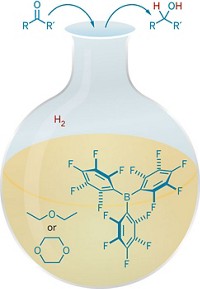Advertisement
Grab your lab coat. Let's get started
Welcome!
Welcome!
Create an account below to get 6 C&EN articles per month, receive newsletters and more - all free.
It seems this is your first time logging in online. Please enter the following information to continue.
As an ACS member you automatically get access to this site. All we need is few more details to create your reading experience.
Not you? Sign in with a different account.
Not you? Sign in with a different account.
ERROR 1
ERROR 1
ERROR 2
ERROR 2
ERROR 2
ERROR 2
ERROR 2
Password and Confirm password must match.
If you have an ACS member number, please enter it here so we can link this account to your membership. (optional)
ERROR 2
ACS values your privacy. By submitting your information, you are gaining access to C&EN and subscribing to our weekly newsletter. We use the information you provide to make your reading experience better, and we will never sell your data to third party members.
Synthesis
Frustrated Lewis Pairs Turn Carbonyls Into Alcohols
Reaction system enables the first metal-free catalytic hydrogenations of ketones and aldehydes
by Stephen Ritter
October 29, 2014

Metal-free catalytic reactions provide an attractive alternative to transition-metal catalysts and stoichiometric reagents, which can be toxic, expensive, and generators of excessive waste. Two research groups have now independently devised the first metal-free catalytic hydrogenations of ketones and aldehydes to make alcohols, one of the most fundamental reactions in chemistry.
The reactions leverage so-called frustrated Lewis pairs (FLPs), in which a sterically encumbered Lewis acid and Lewis base work as a cooperative catalyst system to activate small molecules such as H2 to functionalize unsaturated organic molecules.
“Catalytic reduction of carbonyl compounds by dihydrogen had for a long time been considered a domain of metal-containing systems,” comments Gerhard Erker of the University of Münster, in Germany, whose research includes FLP chemistry. “It is very remarkable that this important catalytic transformation has now been achieved metal-free. This significant development will help make frustrated Lewis pair chemistry increasingly useful and visible.”
In one of the new reports, Andrew E. Ashley and coworkers of Imperial College London coupled the bulky Lewis acid B(C6F5)3 with the Lewis base 1,4-dioxane, which also serves as the solvent. After adding H2, the researchers hydrogenate various alkyl and aryl ketones and aldehydes to make alcohols (J. Am. Chem. Soc. 2014, DOI: 10.1021/ja5088979). In a second report, Douglas W. Stephan of the University of Toronto and his group, who introduced the FLP concept in 2006, coupled B(C6F5)3 with diethyl ether and H2 to convert an array of alkyl and aryl ketones to alcohols (J. Am. Chem. Soc. 2014, DOI: 10.1021/ja508829x).
The secret to the new catalytic process, Stephan says, is the judicious choice of weakly basic ethers as solvents. The ethers optimize hydrogen-bonding with the transient protonated carbonyl and promote hydride delivery to the C=O double bond. Even so, the approach isn’t ideal, researchers say. Transition-metal catalysts still provide better selectivity for performing asymmetric hydrogenations. And although the reactions do eliminate the need for transition metals, the fluorinated aromatic Lewis acids persist in the environment.
“These studies represent a major advance in metal-free catalyzed hydrogenations,” says Warren E. Piers of the University of Calgary, who often uses B(C6F5)3 in homogeneous catalytic reactions. “The clever use of weakly donating solvents to moderate the acidity of the reaction conditions has overcome a long-standing problem of catalyst degradation associated with hydrogenation of carbonyls using FLP strategies. While activities are moderate, these results provide a firm foundation to build on for the future.”





Join the conversation
Contact the reporter
Submit a Letter to the Editor for publication
Engage with us on Twitter